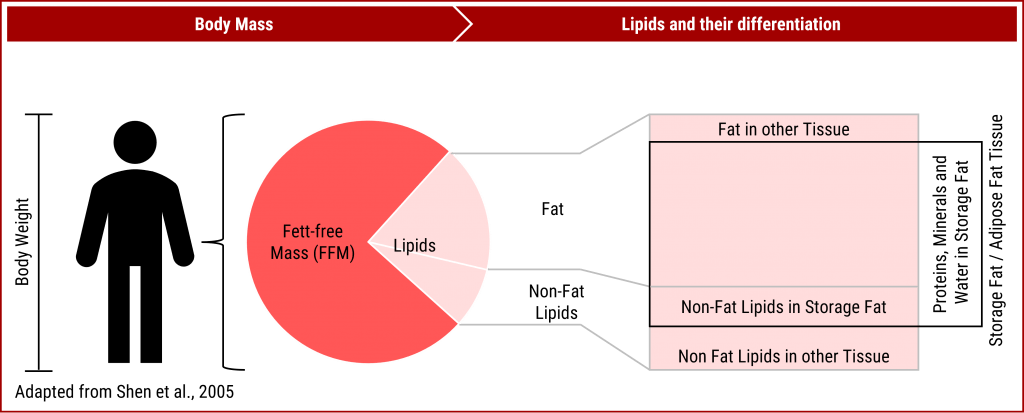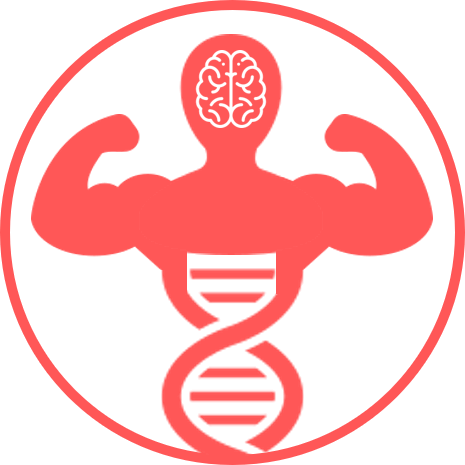Body Composition Basics # 1
Teaser & Intro
Let’s say you want to lose weight – or rather, lose fat. You follow a diet for two weeks and step on the scale every day. At the end of the two weeks, you notice that you are 3 kg lighter and are happy that you have lost a lot of fat. In this and the following posts, we explain why the 3 kg of lost weight are only partially helpful to evaluate the success of your diet and how you should proceed instead.
In this series on Body Composition Basics you will learn …:
- … what our body is made of.
- … which measurement methods can be used to determine body composition, why you should measure your body composition regularly and how best to track and evaluate your progress in physique development (muscle building and fat loss).
- … more information about muscle and fat tissue, how the different types of tissue and our body composition affect our performance and health, why it is important to achieve and maintain a “healthy” body composition, and what reference values and standard ranges exist for a “healthy” body composition.
- … first information on how you can influence your body composition (more on this in later series).
This post is about the basics of the basics: the composition of our body. We will explain to you which models there are for dividing the body into its various components – also called compartments. You will also find out which model is most useful for you if you want to keep an eye on your physique development and your health in general.
Note: This post contains Read-for-Geeks sections. In these we go into the scientific background in detail. If this is too much information for you, you can simply skip these sections and go directly to the application recommendations.
Body Composition: What our body is made of
In general, our body is made up of mass. There are different types of mass. Depending on what these types of mass are made of and what properties they have, a distinction is made between different tissues – e.g. fat, muscle or body water.
The body is divided into different types of tissue using different “compartment models”. These differ depending on the compartments considered or the possible differentiation sharpness.
Models & Compartments
1C Model: Body weight only
In the 1C model, body weight is not divided at all, but only the total mass – i.e. the body weight as a whole – is considered. This means that in this model, body composition consists of only one type of mass and can be easily determined using a normal body weight scale.
2C Model: Fat mass & fat-free mass
In the 2C model, body weight is divided into two components: fat mass (FM) and fat-free mass (FFM) [1]. FM includes all the fat in the body, i.e. not only the adipose storage fat under the skin (and organs), which in everyday life is often referred to exclusively as “body fat”, but also essential fat in other body cells or cell walls (e.g. in the bone marrow or neurons).
FFM therefore contains all non-fat components (organs, bones, muscles, and body water – not contained in fat cells). A term that is often equated with the FFM is lean body mass (LBM). However, FFM and LBM differ in that the LBM also includes essential fat (e.g. in the cell walls of neurons) [2]. In total, essential fat (i.e. the difference between FFM and LBM) amounts to around 3 – 5% of body weight [3]. Since this proportion is not practically relevant in many cases and changes little over time especially when tracking, the distinction is not very important.
The reason for the distinction into only two compartments lies in the assumptions of the underlying measurement methods [4]. Generally, one of the compartments is determined (depending on the measurement method), and the other compartment is derived from the difference to the total body weight.
3C Model: Fat mass, protein & mineral components
The 3C model is an extension of the 2C model, in which the FFM is further divided into mineral (bone) and protein components (metabolic tissue such as muscles and organs) [4].
4C Model: Fat mass, protein & mineral components, body water
The 4C model is an extension of the 3C model, in which body water is also considered in a differentiated manner (total body water; TBW). In this case, a distinction is made (depending on the method) between extracellular (ECW) and intracellular (ICW) body water. The FFM therefore consists of mineral components (bones), metabolic protein tissue (e.g. muscles and organs), ICW located in the cells of the protein tissue, and the ECW outside these cells. The metabolic protein tissue with the contained ICW corresponds to the body cell mass (Body Cell Mass; BCM) [5].
The 4C model and its measurement are based on different assumptions than the 2C and 3C models. The most important thing briefly: These assumptions relate to the constancy or variation in the relationship between the components of the FFM. The 4C model and the underlying measurement methods allow for a more detailed measurement and evaluation of body composition over time [6] and is therefore often considered the gold standard to evaluate body composition (more on this in the next posts on measuring body composition).
Overview 1C to 4C Model of Body Composition

5C & 6C Model
Just for the sake of completeness: There are also models, the 5C and 6C models, that divide the body into even more compartments – especially with regard to the FFM [7] [8]. However, these are not suitable for everyday use and are therefore not of interest here.
Read-For-Geeks: Further levels of differentiation and classifications
In addition to classifying body composition according to tissue types, other levels of differentiation can also be used [7]. Firstly, the atomic level: Here, body weight is divided into oxygen, carbon, hydrogen and other atoms. This level has no meaningful application in everyday life except in the research context.
Secondly, the molecular level: Here, body weight is divided into the chemical compounds water, lipids, proteins and other compounds. This level provides clues for understanding the relationships between the various body compartments – especially fat – at “higher” levels such as the cellular level [9]. The cellular level corresponds to the fourth level and divides the body into fat, bones, blood, organs and skeletal muscles according to a 5C model. This classification is conceptually helpful, but not or only partially possible in everyday life. Nevertheless, in combination with the second (molecular) level, the various compartments and their importance for physique development as well as physical performance and health can be understood in more detail (see graphic below).
Between the second and fourth levels lies the third level: the cellular level. It divides the body into cell mass, extracellular fluid and extracellular solid components. In connection with various compartment models and also as a link between the second and fourth levels, it represents an important conceptual and measurement methodological level.
Lipids and Fats in the Body: Relationship of Molecular and Tissue Level

Application Recommendations: Which model of body composition is suitable for everyday use
Without question, the most common and most frequently used model in everyday life (at least unconsciously) is the 1C model, which is only about body weight as a whole. Most people have a scale at home and use it more or less regularly. Body weight and especially its change over time (e.g. during a fat-loss diet) does provide valuable information, but is only of limited use, especially in terms of a detailed measurement of muscle mass and muscle building.
On the other hand, the 5C and 6C models are unsuitable for everyday use due to their complexity – and because their compartments cannot be measured privately – and are actually only used in research. The 3C model does provide more information than the 2C model, but is not much more helpful at least for determining muscle mass and tracking muscle building, as it cannot distinguish between body water and muscle tissue. In addition, the measurement methods are also not suitable for private use.
The 2C and 4C models are therefore particularly suitable for tracking and evaluating physique development. The 2C model is largely sufficient for assessing body fat percentage (%BF) and its changes, although adipose fat cannot be considered separately from essential fat. However, essential fat is relatively constant compared to adipose fat. Therefore, the 2C model is at least significantly better suited to tracking in a fat-loss diet than just body weight according to the 1C model.
The 4C model, on the other hand, is generally the gold standard and provides the most helpful information when it comes to measuring physique development. On the one hand, the statements about changes in FM are more precise because they are measured separately from changes in body water, which is why the 4C model is also better suited to tracking during a fat-loss diet than the 2C model [6]. In addition, the 4C model is also better suited for measuring and tracking muscle (building), as the FFM distinguishes between body water, bone mass and protein tissue, and can therefore at least determine the net tissue increase. Even if the mass of the organs is also measured in protein tissue, this is largely constant compared to the muscles, so that at least one receives indicative information for evaluating progress in muscle building.
In addition, the measurements of the components in the 2C and 4C models are also easy to carry out privately and at comparatively low cost. You can find out more about this in the next posts on measuring body composition.
Take-Aways
Body composition refers to the composition of the body. Different models are used to differentiate between compartments made up of different types of tissue.
The simplest model is the 1C model, in which body mass is not separated into compartments but considered as a whole. Tracking weight with a body scale provides valuable information, but is only of limited use when viewed on its own.
The 2C model distinguishes between fat mass (FM) and fat-free mass (FFM), which provides a good basis for evaluating physique development, especially in a fat-loss diet. The 4C model also divides the FFM into further components, which is why relatively precise assessments of muscle building in physique development can be made based on the protein tissue compartment.
Outlook
The next posts will be about measuring body composition. There you will learn which measurement methods can be used to determine the individual compartments in the models. The focus here is on the 2C and 4C measurement methods.
But above all, you will learn how to go about measuring in order to get reliable information about your progress in physique development. This is essential in order to be able to make the right adjustments if something gets out of hand.
References
[1] C. Lukaski, “Methods for the assessment of human body composition: traditional and new,” Am. J. Clin. Nutr., vol. 46, pp. 537–556, 1987.
[2] S. Yu et al., “Lean body mass: the development and validation of prediction equations in healthy adults,” BMC Pharmacol. Toxicol., vol. 14, no. 1, pp. 1–9, 2013, doi: 10.1186/2050-6511-14-53.
[3] S. Janmahasatian, S. B. Duffull, S. Ash, L. C. Ward, N. M. Byrne, and B. Green, “Quantification of Lean Bodyweight,” Clin. Pharmacokinet., vol. 44, no. 10, pp. 1051–1065, Oct. 2005, doi: 10.2165/00003088-200544100-00004.
[4] L. C. Ward, “Human body composition: yesterday, today, and tomorrow,” Eur. J. Clin. Nutr., vol. 72, no. 9, pp. 1201–1207, Sep. 2018, doi: 10.1038/s41430-018-0210-2.
[5] U. G. Kyle et al., “Bioelectrical impedance analysis—part I: review of principles and methods,” Clin. Nutr., vol. 23, no. 5, pp. 1226–1243, Oct. 2004, doi: 10.1016/j.clnu.2004.06.004.
[6] T. Abe, S. J. Dankel, and J. P. Loenneke, “Body Fat Loss Automatically Reduces Lean Mass by Changing the Fat‐Free Component of Adipose Tissue,” Obesity, vol. 27, no. 3, pp. 357–358, Mar. 2019, doi: 10.1002/oby.22393.
[7] Z. Wang, R. Pierson, and S. Heymsfield, “The five-level model: a new approach to organizing body-composition research,” Am. J. Clin. Nutr., vol. 56, no. 1, pp. 19–28, Jul. 1992, doi: 10.1093/ajcn/56.1.19.
[8] Z. Wang et al., “Six-compartment body composition model: Inter-method comparisons of total body fat measurement,” Int. J. Obes., vol. 22, no. 4, pp. 329–337, Apr. 1998, doi: 10.1038/sj.ijo.0800590.
[9] W. Shen, M. P. St-Onge, Z. Wang, and S. B. Heymsfield, “The science of body composition research,” in Human Body Composition, Chicago, pp. 1–14.


